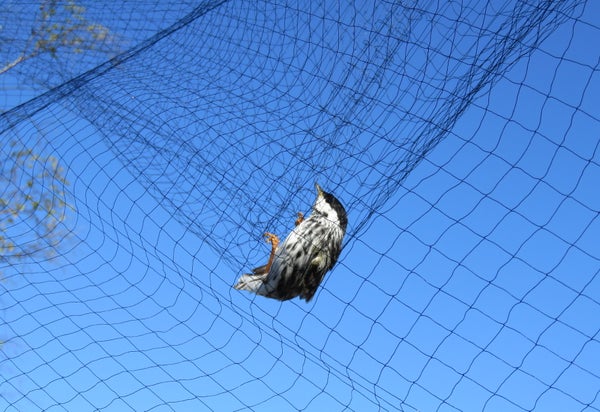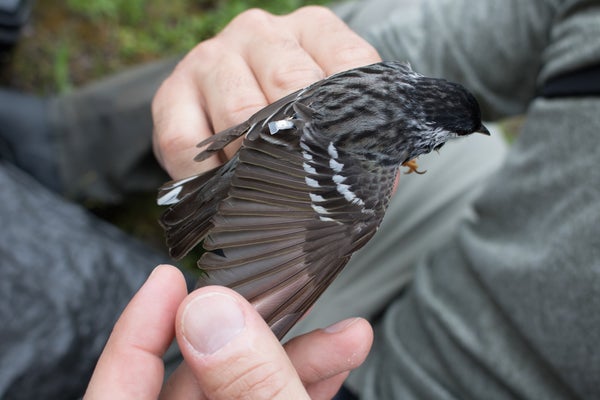This article was published in Scientific American’s former blog network and reflects the views of the author, not necessarily those of Scientific American
On a warm June morning in 2016, a male blackpoll warbler was busy defending a breeding territory near Whitehorse, Yukon. Singing its high-pitched trilling song, it moved from perch to perch to signal to other male blackpolls that it had staked its claim on that small piece of boreal forest wetland.
It was about to be tasked with important work. A team of scientists and local collaborators was looking to this tiny male blackpoll and others like it for help in understanding the migratory route of one of North America’s smallest songbirds.
Today, 37 percent of all North American bird species are considered at risk of extinction if urgent conservation action isn’t taken. Among those experiencing the greatest population declines are long-distance migrants like the blackpoll warbler—species that breed in the northern parts of North America in the warmer months and, in winter, fly south to South America.
On supporting science journalism
If you're enjoying this article, consider supporting our award-winning journalism by subscribing. By purchasing a subscription you are helping to ensure the future of impactful stories about the discoveries and ideas shaping our world today.
Migratory birds face threats at all stages of their annual life cycle, including everything from habitat loss and extreme weather events to collisions with buildings and death by cat. To help the birds, we need to know where they face threats throughout their life cycle, and that means better understanding their migration routes.
.jpg?w=600)
Credit: Hilary Cooke
Blackpoll warblers are one of the fastest declining North American land birds, suffering an estimated 95 percent population decline since 1970. They breed in forested wetlands across the boreal from Alaska to Newfoundland, as well as in isolated montane fir forests at the southern periphery of their range in the northeastern United States. They are long-distance migrants, wintering in the Amazon basin of South America.
Until recently, the precise migratory routes of most North American songbird species were unknown. While real-time movements of large birds such as raptors, waterfowl and shorebirds had been mapped using satellite trackers carried by the birds, songbirds were too small to bear the weight.
About a decade ago, technology caught up. Weighing just half a gram including a harness, archival light-level geolocators are light enough to be carried by some of the smallest warblers. But retrieval of the information on them isn’t simple; the bird must be recaptured to access it.
Over the past century, scientists and naturalists had been piecing together the blackpoll’s migratory route by comparing observations of individuals in various locations and at different times during the spring and fall migration period.
But suspected transoceanic flights from New England and Atlantic Canada to South America could not be confirmed until 2015, when our colleagues used geolocators on blackpolls in Canada’s Maritime Provinces and in New England to document a nonstop, three-day, 3,000-kilometer transoceanic flight to South America during fall migration.
To accomplish this flight, blackpolls nearly double their body mass and take advantage of a shift in prevailing wind direction to help carry them to their destination.
But what about those birds breeding in northern and western Canada and Alaska? Did that male blackpoll we had watched vigorously defending its small patch of Canada’s Yukon Territory—soon to become blackpoll no. 14 in our study—also fly nonstop over the Atlantic or did he take some still unknown inland route? In June 2016, our team captured and fitted 120 birds with geolocator backpacks. A year later, we located 20 of them and the data we recovered revealed an astonishing journey.

A blackpol warbler, trapped in a mist net so it can be fitted with a geolocator backpack. Credit: Hilary Cooke
In the year since we first captured Yukon blackpoll no. 14, he had made his way eastward across Canada’s boreal, traversing the Northwest Territories before turning south at Hudson Bay in Ontario. His southward journey landed him somewhere around the Carolinas where he stopped to rest and refuel before his transoceanic flight. Then, just like his eastern cousins, he made a 3,000-km, nonstop flight to reach Colombia, before settling in the Amazon basin in Brazil for the winter.
In spring, blackpoll no. 14 took a more direct route back to the Yukon, crossing the continent in about a month to return to the patch of boreal wetland where we first encountered him a year before. This 12-gram songbird had just completed a 20,000-km round-trip navigating across continents and oceans. And after a short breeding season, he would do it all over again.
The roughly 20,000-km journey is one of the longest recorded roundtrip migrations for a small songbird. Some of the blackpoll overwater flight distances are on the edge of what was previously thought possible given the fuel requirements for a bird this size. This tiny blackpoll covered 1,800 km for every gram of body weight. By comparison, the well-known round-trip migration of the Arctic tern is close to 40,000 km, but at 100 grams, they average 400 km per gram.
For blackpolls breeding in Alaska and Yukon, a full three months of the year is taken up by migration, with long distances traveled across the continental U.S., exposing individuals to a multitude of threats along the way, which in addition to cats, collisions and extreme weather can be added poor-quality habitat, such as where pesticide use has decimated insect populations.
Our study has identified a couple of potential stopover sites where we can focus conservation efforts, in particular, areas along the Atlantic coast where blackpolls funnel toward their great ocean leap. Canada’s boreal forests may offer comparatively greater protection on the first and last leg of the blackpoll’s fall and spring travels. But this region has largely been protected from large-scale industrial development by its sheer size and remoteness—not by good conservation planning.
This Earth Day, and every day, we must act deliberately and consciously to stop the steady decline of blackpolls and other boreal songbirds by protecting this globally important songbird nursery, and one of the last intact places in the world, North America’s boreal forest.
